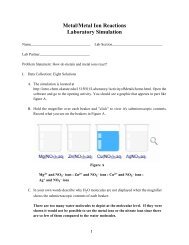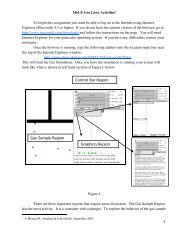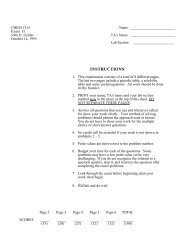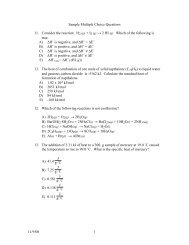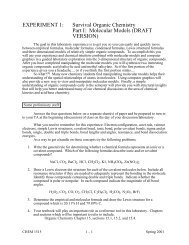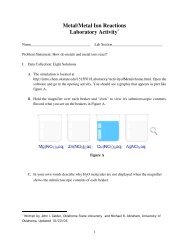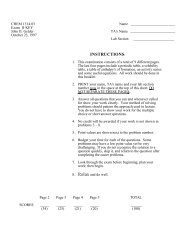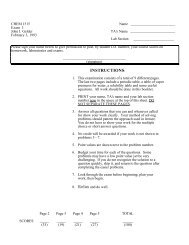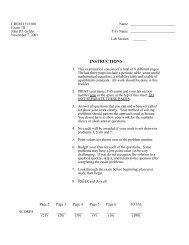CHEM 1314 1 FALL 2000 Chem 1314 Section 3 InClass Exercise ...
CHEM 1314 1 FALL 2000 Chem 1314 Section 3 InClass Exercise ...
CHEM 1314 1 FALL 2000 Chem 1314 Section 3 InClass Exercise ...
You also want an ePaper? Increase the reach of your titles
YUMPU automatically turns print PDFs into web optimized ePapers that Google loves.
<strong>Chem</strong> <strong>1314</strong> <strong>Section</strong> 3<br />
<strong>InClass</strong> <strong>Exercise</strong> #2<br />
Name__________________________<br />
Fall <strong>2000</strong><br />
TA Name ______________________<br />
Lab <strong>Section</strong> #______<br />
ALL work must be shown to receive full credit. Due at the end of laboratory.<br />
ICE3.1. What volume of 0.778 M sodium carbonate solution must be diluted to 150.0 mLs with water to<br />
reduce its concentration to 0.0234 M Na 2 CO 3 ?<br />
M C · V C = M D · V D<br />
0.778 M · V C = 0.0234 M · 150.0 mL<br />
V C =<br />
0.0234 M · 150.0 mL<br />
0.778 M<br />
= 4.51 mL<br />
ICE3.2. A 0.0945 g sample of CuSO 4 · 5H 2 O is dissolved and diluted to the mark in a 500.0 mL<br />
volumetric flask. A 2.00 mL sample of this solution is transferred to a second 5000.0 mL<br />
volumetric flask and diluted.<br />
a) What is the molarity of the CuSO 4 in the final solution?<br />
⎛1 mol CuSO 4 · 5H 2 O ⎞<br />
0.0945 g CuSO 4 · 5H 2 O ⎝ 250. g ⎠<br />
= 3.78 x 10 -4 mol CuSO 4 · 5H 2 O<br />
3.78 x 10 -4 mol CuSO 4 · 5H 2 O<br />
0.500 L = 7.56 x 10 -4 M CuSO 4<br />
M C · V C = M D · V D<br />
7.56 x 10 -4 M CuSO 4· 2.00 mLs = M D · 5000.0 mL<br />
M D = 7.56 x 10-4 M CuSO 4· 2.00 mLs<br />
5000.0 mLs<br />
= 3.02 x 10 -7 M CuSO 4<br />
I meant to a second 500.0 mL volumetric flask<br />
M C · V C = M D · V D<br />
7.56 x 10 -4 M CuSO 4· 2.00 mLs = M D · 500.0 mL<br />
M D = 7.56 x 10-4 M CuSO 4· 2.00 mLs<br />
500.0 mLs<br />
= 3.02 x 10 -6 M CuSO 4<br />
b) To prepare the solution directly what mass of CuSO 4 · 5H 2 O must be weighed out?<br />
⎛3.02 x 10 -7 M CuSO 4⎞<br />
5.000 L ⎝ 1 L ⎠ = 1.51 x 10 -6 mol CuSO 4 · 5H 2 O<br />
1.51 x 10 -6 mol CuSO 4 · 5H 2 O<br />
⎛ 250. g ⎞<br />
⎝ 1 mol CuSO 4 · 5H 2 O ⎠<br />
= 3.78 x 10-4 g CuSO 4 · 5H 2 O<br />
<strong>CHEM</strong> <strong>1314</strong> 1 <strong>FALL</strong> <strong>2000</strong>
ICE3.3. Describe how you would prepare 250.0 mLs of a 0.0100 M solution of KMnO 4 .<br />
⎛0.0100 mol KMnO 4 ⎞<br />
.250 L ⎝ 1 L ⎠<br />
= 2.50 x 10 -3 mol KMnO 4<br />
2.50 x 10 -3 mol KMnO 4 ⎝ ⎛ 158 g KMnO 4<br />
1 mol ⎠ ⎞ = 0.395 g KMnO 4<br />
Weigh 0.395 g KMnO 4 on a balance. Measure out about 200 mL of water and<br />
add the 0.395 g of KMnO 4 to the 200 mL of water. After the KMnO 4 dissolves,<br />
add enough water so the final volume is 250 mL.<br />
ICE3.4. Given the reaction<br />
PbO 2 (s) + HNO 3 (aq) → Pb(NO 3 ) 2 (aq) + H 2 O(l) + 2O 2 (g)<br />
a) Balance the chemical equation.<br />
2PbO 2 (s) + 4HNO 3 (aq) → 2Pb(NO 3 ) 2 (aq) + 2H 2 O (l) + O 2 (g)<br />
b) What volume of 1.23 M nitric acid is required to react with 15.0 g of lead(IV) oxide according to<br />
the equation?<br />
15.0 g PbO 2 ⎝ ⎛ 1 mol PbO 2<br />
239 g PbO ⎠ ⎞<br />
2<br />
= 6.28 x 10 -2 mol PbO 2<br />
6.28 x 10 -2 mol PbO 2 ⎝ ⎛ 4 mol HNO 3<br />
2 mol PbO ⎠ ⎞<br />
2<br />
= 1.26 x 10 -1 mol HNO 3<br />
1.26 x 10 -1 mol HNO 3 ⎝ ⎛ 1 L<br />
1.23 mol HNO ⎠ ⎞<br />
3<br />
= 0.102 L<br />
ICE3.5. Phosphoric aciid can be produced according to the reaction<br />
Ca 5 (PO 4 ) 3 F(s)+ 5H 2 SO 4 (aq) + 10H 2 O(l)→ 3H 3 PO 4 (aq) + 5(CaSO 4 · 2H 2 O)(s) + HF(aq)<br />
a) What volume of 2.50 M phosphoric acid is generated by the reaction of 500. g of Ca 5 (PO 4 ) 3 F<br />
with excess sulfuric acid?<br />
500.0 g Ca 5 (PO 4 ) 3 F<br />
⎛1 mol Ca 5 (PO 4 ) 3 F ⎞<br />
⎝ 504 g Ca 5 (PO 4 ) 3 F ⎠<br />
= 0.992 mol Ca 5(PO 4 ) 3 F<br />
0.992 mol Ca 5 (PO 4 ) 3 F<br />
⎛ 3 mol H 3 PO 4 ⎞<br />
⎝ 1 mol Ca 5 (PO 4 ) 3 F ⎠<br />
= 2.98 mol H 3PO 4<br />
2.98 mol H 3 PO 4 ⎝ ⎛ 1 L<br />
2.50 mol H ⎠ ⎞<br />
3 PO 4<br />
= 1.19 L of 2.50 M H 3 PO 4<br />
b) What volume of 3.00 M sulfuric acid is required to react with amount of Ca 5 (PO 4 ) 3 F in part a?<br />
0.992 mol Ca 5 (PO 4 ) 3 F<br />
⎛ 5 mol H 2 SO 4 ⎞<br />
⎝ 1 mol Ca 5 (PO 4 ) 3 F ⎠<br />
= 4.96 mol H 3PO 4<br />
4.96 mol H 2 SO 4 ⎝ ⎛ ⎠ ⎞<br />
1 L<br />
3.00 mol H 2 SO 4<br />
= 1.65 L of 3.00 M H 2 SO 4<br />
<strong>CHEM</strong> <strong>1314</strong> 2 <strong>FALL</strong> <strong>2000</strong>
ICE3.6. Given the reaction<br />
K 2 Cr 2 O 7 (aq)+ 6Fe(NO 3 ) 2 (aq) + 14H + (aq) → 2Cr 3+ (aq) + 6Fe 3+ (aq) + 7H 2 O(l) + 2KNO 3 (aq)<br />
a) A solution of Cr 2 O 7<br />
2- is prepared by dissolving 9.34 g of K 2 Cr 2 O 7 in 400.0 mL of water.<br />
(Assume no significant change in volume when the solution is prepared.) A total 14.75 mL of<br />
this solution is required to reach the end-point in a titration of a 250.0 mL sample containing<br />
Fe(II). Determine the concentration of Fe(II) in the solution.<br />
⎛1 mol K 2 Cr 2 O 7 ⎞<br />
9.34 g of K 2 Cr 2 O 7 ⎝ 294.2 g ⎠<br />
= 3.17 x 10 -2 mol K 2 Cr 2 O 7<br />
3.17 x 10 -2 mol<br />
0.400 L = 7.94 x 10 –2 M K 2 Cr 2 O 7<br />
⎛7.94 x 10<br />
0.01475 L –2 mol⎞<br />
⎝ 1 L ⎠ = 1.17 x 10 -3 mol K 2 Cr 2 O 7<br />
1.17 x 10 -3 mol K 2 Cr 2 O 7 ⎜ ⎛ 6 mol Fe2+<br />
⎝ 1 mol K ⎠ ⎟⎞ = 7.02 x 10 2 Cr 2 O -3 mol Fe 2+<br />
7<br />
7.02 x 10 -3 mol Fe 2+<br />
0.250 L = 2.81 x 10 -2 M Fe 2+<br />
b) Calculate the mols of H + required to react with the amount of K 2 Cr 2 O 7 (aq) and Fe(NO 3 ) 2 (aq)<br />
used in part a.<br />
1.17 x 10 -3 mol K 2 Cr 2 O 7 ⎜ ⎛ 14 mol H+<br />
⎝ 1 mol K ⎠ ⎟⎞ = 0.0164 mol H 2 Cr 2 O +<br />
7<br />
c) If this number of mols of H + are dissolved in 300. mLs, calcualte the concentration of H + .<br />
0.0164 mol H +<br />
0.300 L = 5.46 x 10 -2 M H +<br />
<strong>CHEM</strong> <strong>1314</strong> 3 <strong>FALL</strong> <strong>2000</strong>
ICE3.7. Write the chemical formula(s) of the product(s) and balance the following reactions. Identify all<br />
products phases as either (g)as, (l)iquid, (s)olid or (aq)ueous. If no reaction occurs write NR.<br />
a) 2Al(s) + Fe 2 O 3 (s) → Al 2 O 3 (s) + 2Fe(l)<br />
b) Na 2 SO 4 (aq) + 2NH 4 Cl(aq) → (NH 4 ) 2 SO 4 (aq) + 2NaCl(aq)<br />
c) Mg(s) + Cu 2+ (aq) → Mg 2+ (aq) + Cu(s)<br />
d) 3Na 2 CO 3 (aq) + 2Fe(NO 3 ) 3 (aq) → 6NaNO 3 (aq) + Fe 2 (CO 3 ) 3 (s)<br />
ICE3.8. Write the ionic and net ionic chemical equations for 1b) and 1d).<br />
1b)<br />
Ionic equation:<br />
2NH 4<br />
+ (aq) + SO 4 2– (aq) + 2Na + (aq)) + 2Cl – (aq) → 2NH 4<br />
+ (aq) + SO 4 2– (aq) + 2Na + (aq))<br />
+ 2Cl – (aq)<br />
Net Ionic equation:<br />
2NH 4<br />
+ (aq) + SO 4 2– (aq) + 2Na + (aq) + 2Cl – (aq) → 2NH 4<br />
+ (aq) + SO 4 2– (aq) + 2Na + (aq)<br />
+ 2Cl – (aq)<br />
All ions cancel..no net ionic equation....no reaction.<br />
1d)<br />
Ionic equation:<br />
6Na + (aq) + 3CO 3 2– (aq) + 2Fe 3+ (aq) + 6NO 3 – (aq) → 6Na + (aq) + Fe 2 (CO 3 ) 3 (s) +<br />
6NO 3 – (aq)<br />
Net Ionic equation:<br />
6Na + (aq) + 3CO 3 2– (aq) + 2Fe 3+ (aq) + 6NO 3 – (aq) → 6Na + (aq) + Fe 2 (CO 3 ) 3 (s) +<br />
6NO 3 – (aq)<br />
2Fe 3+ (aq) + 3CO 3 2– (aq) → Fe 2 (CO 3 ) 3 (s)<br />
ICE3.9. Calculate the mass of manganese(II) sulfate that forms with 0.680 mLs of 2.44 x 10 -3 M KMnO 4<br />
react with 1.25 g of potassium permanganate in excess sulfuric acid. The equation which<br />
describes the reaction between oxalic acid, potassium permanganate and sulfuric acid is,<br />
2KMnO 4 (aq) + 5H 2 C 2 O 4 (aq) + 3H 2 SO 4 (aq) → K 2 SO 4 (aq) + 2MnSO 4 (aq) + 10CO 2 (g) + 8H 2 O(l)<br />
(moles KMnO 4 ) o (moles H 2 C 2 O 4 )required (moles H 2 C 2 O 4 ) o Conclusion<br />
1.66 x 10 -6 4.15 x 10 -6 1.39 x 10 -2 KMnO 4 limiting,<br />
H 2 C 2 O 4 excess<br />
0.680 mLs<br />
⎛ 1 L ⎞<br />
⎝ 1000 mLs ⎠ ⎝ ⎛ 2.44 x 10 –3 mol KMnO 4<br />
1 L ⎠ ⎞ = 1.66 x 10 -6 mol KMnO 4<br />
1.25 g H 2 C 2 O<br />
⎛ 1 mol H 2 C 2 O 4 ⎞<br />
4 ⎝ 90.0 g H 2 C 2 O 4 ⎠<br />
= 1.39 x 10 -2 mol H 2 C 2 O 4<br />
1.66 x 10 -6 mol KMnO<br />
⎛5 mol H 2 C 2 O 4 ⎞<br />
4 ⎝ 2 mol KMnO4 ⎠<br />
= 4.15 x 10 -6 mol H 2 C 2 O 4 required<br />
So KMnO 4 is the limiting reagent<br />
1.66 x 10 -6 mol KMnO<br />
⎛2 mol MnSO 4 ⎞<br />
4 ⎝ 2 mol KMnO4 ⎠ ⎝ ⎛ 151 g<br />
1 mol MnSO ⎠ ⎞<br />
4<br />
= 2.51 x 10 -4 g of MnSO 4<br />
<strong>CHEM</strong> <strong>1314</strong> 4 <strong>FALL</strong> <strong>2000</strong>




